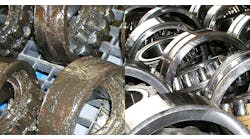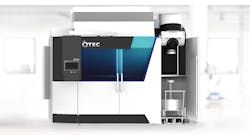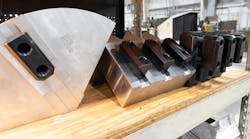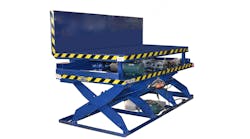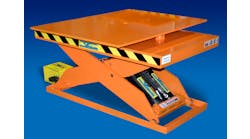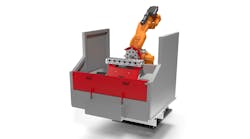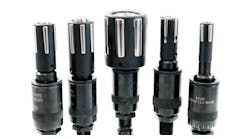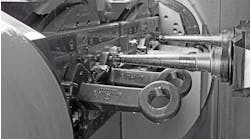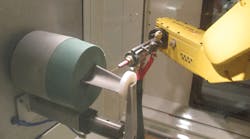Latest from Material Handling
GUYSON CORPORATION developed a seven-axis robotic grit-blast system that automatically changes between blasting tools to perform critical surface preparation work around the exterior of complex-shaped components, as well as recesses and interior surfaces of the parts.
The multi-tasking robotic blast machine incorporates a 6-axis Fanuc M-20iA robot rigidly mounted on a pedestal inside a 60 x 96-inch rotary table blasting cabinet. A custom-tailored suit of laminated fabric isolates the tool-changing robotic nozzle manipulator from dust and media, yet allows the full range of motion of the articulated robot arm. The turntable, bearing an interchangeable component-holding fixture, is servomotor driven and controlled as a seventh axis of coordinated robotic motion, so the precise orientation and rotation of the work piece is a programmed and repeatable element of the automated blast processing routine.
A storage compartment (or “doghouse”) on one side of the blast enclosure securely cradles and positively locates a straight pressure-blast nozzle attached to a custom-designed gun bracket. The doghouse on the other side of the cabinet holds a bracketed lance tool with an angled nozzle that can reach into hollow areas and narrow openings. Vertical sliding doors seal the blast chamber and separate the stored blasting tool from the abrasive environment of the grit-blast machine.
During the robotic blast cycle, the correct blasting tool is automatically selected, based on the process recipe for the particular component being grit-blasted, and the motion program is precisely executed, with the nozzle angle, offset or stand-off distance and surface speed being constantly maintained.
Guyson emphasized that the tool-changing capability of the robotic blast system may be applied to more than two tools, and a variety of other types of blasting tools may be required for other specific process requirements. For instance, separate selectable nozzles may deliver different shot or grit media sizes, or a non-blast tool may be included for certain processing operations.
Designed to be loaded and unloaded by a human operator using a walkie stacker or a separate machine-tending robot, the robotic blasting center enhanced with tool-changing technology is capable of precision automated surface preparation work on a wide variety of components that might previously have required multiple special-purpose blast cabinets or lengthy change-over, set-up and adjustment times. The machine builder claims this introduces a new level of flexibility in lean manufacturing operations, and in many cases, makes unmanned operation possible.
Visit www.guyson.com


